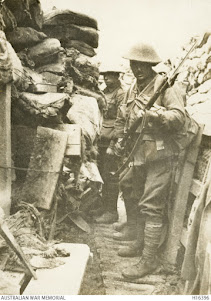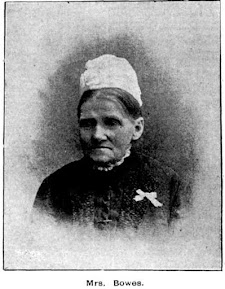The Battle of Pozieres remembered
I couldn't let the month of
July pass without a tribute to some of those who gave their all on the
battlefields on the Western Front in 1916. They never made it home to Australia
but are remembered on family headstones scattered throughout Rookwood cemetery.
After the horror of the
Gallipoli campaign, many were patched up and sailed to France to join British
and other Commonwealth nations troops for arguably worse horrors.
The name Fromelles reminds
many of the battle that caused the single the greatest number of dead Australian troops
in the Great War. There were 5,533 casualties, including approximately 1,900
deaths. The number of dead included 15 sets of brothers and one father and son.
The British Division suffered 1,547. The Germans around 1,500. All the more
shocking when you find that this happened in one 24-hour period; 19th July
1916.
If that was not bad enough,
those that survived the bloodbath of Fromelles were then subjected to the
Battle of Pozieres which ran from July to August 1916. Near that French village
the Australian Imperial Force (AIF) lost as many men over a few weeks as it did
in over eight months on Gallipoli.
The first attack was on the
23rd of July just four days after Fromelles. The 1st Division seized the German
front and reached the main road through Pozieres a short time later, the German
counter-attacked at dawn but were fought off; the rest of Pozieres fell within
the next two days.
Next the 2nd Division took
over Pozieres village by 27th July and were ordered to capture Pozieres
heights. The Germans were ready. There were 3,500 August casualties. The AIF
fought back and seized Pozieres heights on 4th August. The exhausted 2nd
Division were relieved by the 4th Division with another 10 days of action.
When they reached Mouquet Farm the 4th Division were withdrawn and rested. The
Germans held that position until 26th September 1916.
In less than seven weeks
fighting at Pozieres and Mouquet Farm, three AIF Divisions suffered 23,000
casualties. Of these, 6,800 were killed or died of wounds.
Last year I published a blog
about the horror of Fromelles and highlighted the lives of Frederic Leslie
Sainty and William Bentley so this year I will highlight some of those that
took part in the Battle of Pozieres.
Those men are commemorated
on family graves in Rookwood and are as follows -
CHARLES MILLER
Charles was the adopted son
of Mr. Compton Smith and Mrs. Esther Thomasina Miller from Burwood. His adoption
in 1901 at the age of four was from the Central Methodist Mission Children's
Home known as "Dalmar" in Croydon, western Sydney. Charles was their
only child as Compton died in 1902 and his raising became the sole province of
Esther.
Esther gave her consent for
Charles to join the expeditionary forces as he had previously served in the
Citizen Military Forces - a form of the Army Reserve. He enlisted on 7th May
1915 at the age of nineteen and a half years.
After the successful
withdrawal from Gallipoli on 20th December 1915, the 20th Division of which Charles
was attached, proceeded to France and had the dubious honour of being the first
Australian battalion to be raided by the Germans. The 20th took part in it
first major offensive around Pozieres between late July and the end of August
1916.
Charles was killed in action
in the early days of the Battle around Pozieres on 26th July 1916, 107 years
ago today. His Red Cross file contains a statement from an eyewitness that
Charles was mutilated by a burst of shrapnel erupting so close to him to
render him unrecognizable. He could only be identified by his identity disc.
Another witness stated seeing him lying in "no man’s land" as due to
heavy fighting his body could not be retrieved.
After the battle moved on Charles' body was never located and he lies somewhere in the fields of France; his
name carved in stone at the Australian National Memorial at Villers-Bretonneux.
After many years of
correspondence to the War Commission pleading that his parents were unknown,
his adoptive mother Esther was issued with his memorial plaque and medals.
The headstone in the
Independent Old Ground area of Rookwood states "Our beloved Charlie Boy.
he died for England to awake with God."
KENNETH ALLAN BELL
Kenneth, from Ashfield, was
a University Law student at the time of his enlistment in early 1916. He had
taken out a certificate in the Merchant Marines with the intention of becoming
a Marine Barrister. He was offered a commission in the Royal Australian Navy
upon the outbreak of war but declined the offer to join the Army. Upon
enlistment Kenneth was enrolled as a Lieutenant.
He was killed in the first
wave at Pozieres also on the 26th of July 1916, 107 years ago today.
Kenneth was buried near the battlefield at the time. Fortunately, his body was
later located, and he now lies in the Pozieres British Cemetery in France.
His file contains a great
deal of correspondence between his father, Robert, and the War Office about a
missing personal revolver from his extensive kit which was subsequently
returned to Australia early in 1919 and the matter never resolved. Perhaps someone souvenired it from the battlefield - that was not unknown to occur. Robert Bell died later in 1919 never receiving his
son’s Memorial Scroll or Plaque.
The family headstone states
that Kenneth, “a beloved son… died aged 26 years.” It is also noted that Robert
died on 1st July leaving his wife, Amelia to mourn both her husband
and son every July until her death in 1938.
EDWARD JOHN FITZGERALD
Edward was originally from
New Zealand but at the time of his enlistment in November 1915 was living in
Homebush a suburb of Sydney near the Necropolis. After training in Egypt, he
was dispatched to the Western Front where he suffered a bout of influenza in
April 1916. He was designated fit for action on 18th June but just over a month
later on 24th July he was reported as Killed in Action which was
altered to “missing” as his
body was not found. A Court of Inquiry on 14th June 1917 updated the status to
KIA.
This news must have been distressing for his mother, Ellen, as her husband,
James, had died in February, just a few months before.
Edward was originally listed as having no known grave and his name was carved
on the Villers-Bretonneux Memorial, however, on 30th July 1937, a
letter was forwarded to his mother with his identity disc, stating that his
body had been found and that he had been reburied with full honours at the London
Cemetery extension at Longeval France. Unfortunately, Ellen had died in June
1933.
It is generally acknowledged that Pozieres was a victory – but at what
cost?
In the words of the Australian official historian Charles Bean, the
Pozieres ridge “is more densely sown with Australian sacrifice than any other
place on earth.”
For today’s blog I have referenced the Australian War Memorial’s information
on Pozieres and various photographs from their extensive collection, National
Archive of Australia enlistment files and Wikipedia.
I will close this blog referencing the anti-war song lyrics of “War” written
by Norman Whitfield and Barrett Strong in 1969 and originally sung by The
Temptations.
“War what is it good for? Absolutely nothing.”
RIP. Lest We Forget
If you have any comments regarding this blog please add them below of at the Group Facebook Page found under
rookwoodcemeterydiscoveries
Of send me a personal message at my email address
Until next week.








This was so interesting with what they endured back then we still do the same today ?
ReplyDeleteConflict changes as technology alters but its aim remains the same tragically
Delete